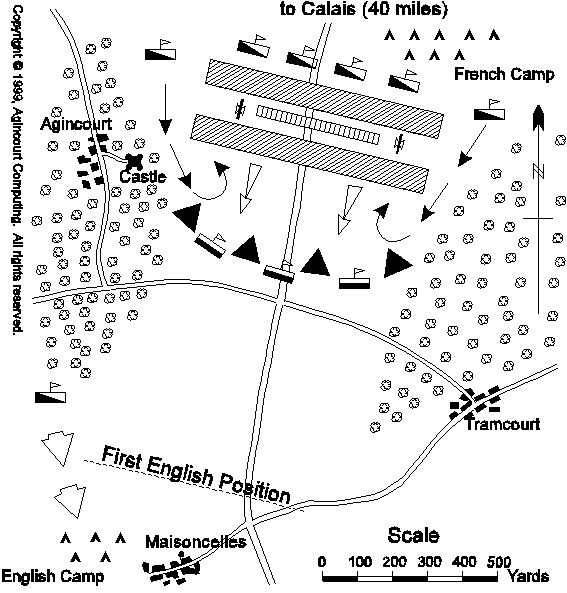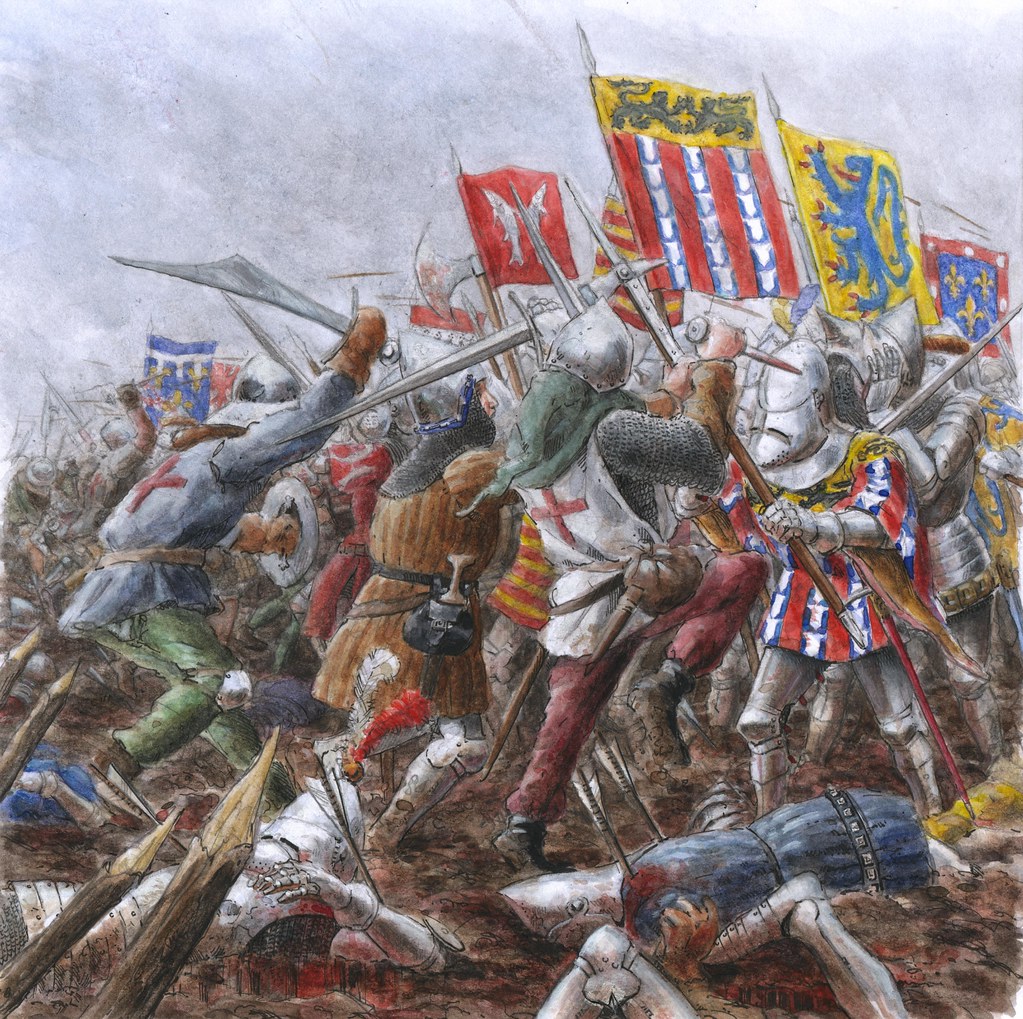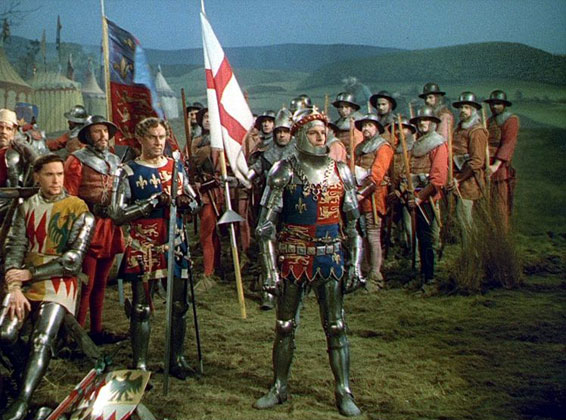We few, we happy few, we
band of brothers;
For he to-day that sheds his blood with me
Shall be my brother; be he ne’er so vile,
This day shall gentle his condition;
And gentlemen in England now-a-bed
Shall think themselves accurs’d they were not here,
And hold their manhoods cheap whiles any speaks
That fought with us upon Saint Crispin’s day.
For he to-day that sheds his blood with me
Shall be my brother; be he ne’er so vile,
This day shall gentle his condition;
And gentlemen in England now-a-bed
Shall think themselves accurs’d they were not here,
And hold their manhoods cheap whiles any speaks
That fought with us upon Saint Crispin’s day.
Henry V – William Shakespeare
In 13th August
1415 Henry V, with 12,000 men, landed in France to further his claim to the
French crown and lands through his Great Grandfather, Edward III. His claim to
the throne of France was a tenuous casus belli for Henry, but in truth the Hundred
Years War had always been about territory.
The Norman Conquest of England had created the strange
situation that a supposed subject of the French Throne (Duke of Normandy) now
had lands and military power equal or exceeding that of his liege lord. Subsequently
the French Crown had long endeavoured to conquer French lands ruled by the
English monarchy such as Aquitaine, Normandy, Brittany and Flanders. By 1415 only Aquitaine and Calais remained
under English rule but France itself was riven by civil war between Charles VI
and John the Fearless, Duke of Burgundy. Seeing a chance to rebuild the Angevin
Empire Henry V resumed the Hundred Years War.
The siege of the port Harfleur lasted until 22nd September
and took its toll on Henry’s forces as disease thinned his ranks, but he waited
for the Dauphin - the heir apparent to the French Crown, to respond. By October
the campaigning season was coming to an end and a costly expedition had only
yielded one town. The French had so far failed to challenge Henry militarily. Therefore,
in order to ensure his claim to Normandy and Flanders more substantial than
merely historical, he chose to march to Calais, rather than retire directly
overseas to England for the winter.
Biding their time the Dauphin had gathered an army around
Rouen. They shadowed the English, blockading crossings of the river Somme and
forcing Henry south to find a ford.
Finding a crossing at Peronne he resumed his march northwards. The
French followed but without the protection of the river hesitated to give
battle. Yet all the time the French were growing stronger as reinforcements
arrived. In contrast, after a 16 day march of 260 miles, the English were in a
pitiful state; wracked by disease and short of supplies. On 24th
October both armies faced each other across a narrow strip of freshly ploughed
open ground between the woods of Agincourt and Tramecourt. The English were at the south while the
French positioned themselves at the north, barring the road to Calais.
Throughout the night it rained. Cold, wet and hungry the English settled as
best they could, for what many considered would be their last night on earth.
On 25th Henry, fearing further French
reinforcements, arrayed his forces for battle. He positioned his English and
Welsh longbowmen on his flanks behind sharpened stakes, angled so as to create
an enfilade killing ground. In the centre he placed his heavily armoured men at
arms, in three battles, behind more archers. The French clearly outnumbered the
English force. We only have estimates but the English now ranged from 6-9000,
5/6ths being commoner archers, the rest being heavy infantry. The French had
anything 12-36,000, some 10,000 being men-at-arms, with 1200 mounted knights. The rest
would be other infantry consisting of crossbowmen and archers.
Despite this clear numerical advantage the French sat awaiting
further reinforcements. Perhaps they expected
the English to retreat at the sight of so many enemies? If defeated the English
men at arms could expect to be captured and ransomed, whereas the archers would
be killed outright. Henry knew his men were in a poor state, with hunger
beginning to afflict them; he therefore took a gamble and advanced closer to
the French. If the French had attacked at this point before the English had
reset their anti-cavalry stakes the result would have been a slaughter, but for
some reason no action was taken. Impatient for battle, with the French at 300
yards, Henry’s longbowmen released a volley. The air turned dark with arrows,
that made a sound like rushing water. The sheer numbers of arrows meant that
some were bound to find exposed areas of flesh amid the opposing ranks. Incensed
and stung into action, instead of answering with their own archers and
crossbowmen, the French cavalry charged.
The charge was a disorganised disaster; many were still
feeding or watering their mounts. The cavalry were unable to outflank the archers,
protected as they were by the woods behind them and the forest of spikes in
front of them. Instead they were funnelled into the killing ground where arrows
pierced the horses’ unprotected flanks. Those horses that completed the
nightmare journey found themselves impaled on the fence of sharpened stakes. Soon
all was a chaos of maddened horses and thrashing limbs. Expecting to mop up
after the shock of the cavalry charge 5000 French men-at-arms began their
advance, only to face retreating horsemen and stampeding arrow maddened horses.
In full plate armour they faced an energy sapping 300 yard slog through the now
hoof-churned mud and the shambles of fallen comrades. All the time a deadly storm
of arrows rained on them. They had to bend their heads down to protect the eye
slits in their visors and yet they made it to the English line and by weight of
numbers managed to push the English men-at-arms back.
Their arrows spent and needing to retrieve usable
ammunition, the longbowmen took up swords, hatchets and mallets and attacked
from the flanks. The French men-at -arms were exhausted and were butchered by
the manoeuvrable light infantry. Many were knocked over, too exhausted to
defend themselves or rise again. It is very possible that many suffocated in
the shambles of mud and bodies. The French second line advanced but merely disappeared
in the crush making it increasingly impossible for those at the front to fight
or manoeuvre. For three hours the slaughter continued; men were killed or
captured in their thousands. It was said that great heaps of dead began to
mount up in front of the three English battle standards, both French lines
utterly defeated. Thousands of French nobles were disarmed it was said they
actually outnumbered their captors.
Looking up from the slaughter the tired English army saw the
French still gathered at the north with reinforcements still arriving, they
seemed to be forming up for another attack. These reserves still outnumbered
Henry’s forces and were fresh. Screams were heard behind them as French forces
had rounded their position to attack Henry’s baggage train. Despite all their
valiant efforts, defeat was still a real possibility for the English; those
taken prisoner could easily snatch an abandoned weapon and join in the fray.
Not prepared to accept such an outcome Henry ruthlessly ordered the prisoners
to be killed.
Such an act of terror is still controversial, many of Henry’s
knights refused to embark on such an unchivalrous act and most of the archers
had returned to their defensive positions seeing the French to the north preparing
to advance. Those killed at this time would have probably gone into the hundreds,
but it had the desired effect. The French reserve saw the captured nobles being
slaughtered and, deciding that the battle was truly lost, fled the field.
Seldom are victories so crushing and decisive, the ratios of
those killed is astonishing. Some sources list 4-11,000 French dead to 1600
English and Welsh, others 7-10,000 to little over 100. It was a classic battle using
the longbow and is rightly remembered as the epitome of English tactics of the
period, perhaps more so than the similarly fought battles of Crecy and Poitiers.
It also shows that overwhelming numbers do not necessarily ensure victory.
The French allowed Henry to manipulate them into attacking him recklessly over
terrain that suited a defensive posture. Thanks to Shakespeare of course the
battle has entered the national psyche, a symbol of backs to the wall defiance;
how stirring words can bolster fear-filled hearts.
Rob Bayliss is a reviewer at The Review and is currently writing his own fantasy series. Information on his writing projects can be found at Flint & Steel, Fire & Shadow.






Nice work, Rob.
ReplyDeleteGreat post Rob!
ReplyDeleteGreat post Rob!
ReplyDeleteGreat post Rob!
ReplyDeleteThank you so much for posting this post Rob. I can see a lot of research has gone into it. It really kept me gripped till the end! Fabulous writing!
ReplyDelete